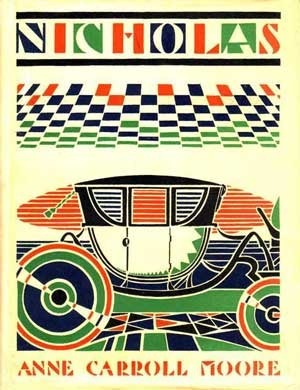The premise of Nicholas: A Manhattan Christmas Story by Anne Carroll Moore (published 1924) sounds so promising. An eight-inch sprite-elf-boy (not sure exactly what he is) comes to Manhattan from the Netherlands for a Christmas to remember! After doing all sorts of Christmas shopping and visiting, he has a midnight party in the library, where all the book characters come to life. But the details in Nicholas dooms the book for today’s children. The author describes the streets and shops on the streets in meticulous detail and many of the characters appear with no background information, making the book of no general interest for those unfamiliar with the minutiae.
I’ll give a little credit. Some people may enjoy Anne Carroll Moore’s Nicholas. An historian familiar with 1924 Manhattan, including the popular shops on the streets, common parks and landmarks, and so forth, would enjoy tracking the journeys taken throughout the novel from Christmas Eve to George Washington’s birthday. And, children’s literature experts would enjoy the spattering of literary friends and characters appearing as Nicholas’ entertainers and guests. During the Christmas party in the library, characters jump out of the library books. I know the fairy tale characters and even some other familiar ones appear (such as Dr Doolittle and Alice in Wonderland) but so many of the others are just simply unknown to me. That said, those who are well acquainted with the now-unknown children’s literature of the late 1880s and early 1900s may be delighted to recognize their favorites. Maybe a student of children’s literature during these eras would enjoy creating a gloss for the entire book, providing images, snippets, and general explanations to explain these now obscure references.
But the book lacks so much, character and plot included. Nicholas, as a strange eight-inch being, is never himself explained, and as he travels from one exciting place to the next, he never changes or develops, his friendships are never grown or challenged, and nothing ever happens other than hearing stories about the exciting people (such as Nathaniel Hawthorne and George Washington) that once walked where he now walks. Nicholas is supposedly only eight-inches tall, but he walks the streets, enjoys the theater, and takes the taxi with regular sized people who are simply delighted to see him (again?). Although there are some children who are his playmates in various scenes and they are always excited to see Nicholas, the reader has no idea who they are. The complete lack of character development makes them all fall flat in memory even two pages later.
Nicholas’ main friend and companion throughout the book is Anne Carraway, a librarian who is obviously a stand-in for the author herself, Anne Carroll Moore, a librarian in the New York Public Library. I can only refer the future reader of Nicholas to other places to get an understanding, as I did, just who Anne Carroll Moore was. On her Wikipedia page, we learn about her important impact to children’s literature development and librarianship in the early 1900s, and in “The Lion and the Mouse” New Yorker article, we learn that she actually had an eight-inch doll she called “Nicholas Knickerbocker” who she used in her library storytimes. Apparently she treated him like an imaginary friend and so one else was sad when the doll was lost. What this book tells me is that although she may have been a very interesting person and influence on the progress of children’s literature, she really did not have a good ability to write a well-spun story for children that met the criteria she herself created for good quality children’s literature.
Nicholas: A Manhattan Christmas Story was awarded a Newbery Honor in 1925, and I sincerely believe it must have been because Anne Carroll Moore was the author as well as an influential librarian in the ALA, not because it was any good as a children’s book. I didn’t notice problematic racism in it as I did in the other early Newbery books, but there was very little reason to suggest it as a good read for anyone today. I rate it as okay and say don’t bother.
Newbery rating scale: FANTASTIC | REALLY GOOD | PRETTY GOOD | OKAY | BLAH/YUCK
What to do with this Newbery: KEEP IT AND READ IT | MAYBE IF YOU HAVE TIME | DON’T BOTHER




